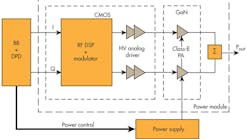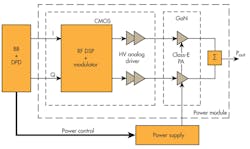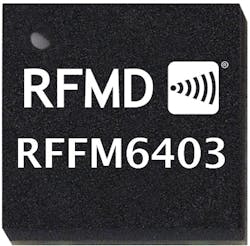Energy efficiency is becoming increasingly important as a means of reducing greenhouse emissions, especially as data traffic has grown due to the unprecedented development and growth in global wireless communications systems over the last decade. Network operators look for the highest possible efficiency in the networks they deploy, which puts pressure on components suppliers to deliver products that are as efficient as possible, especially higher-power active components such as power amplifiers (PAs).
Related Articles
• Software Speeds PA Design
• Design An ETSI E-Band Circuit
• Digital Predistortion Linearizes RF PAs
A significant portion of the wireless base station power budget is consumed by the transmit RF PA. Since the PA can account for more than one-half of the base station's power usage, PAs have been the focus of efforts to improve power-added efficiency (PAE). The PAE is a measure of how well a PA can convert DC power into RF/microwave power. A PA’s PAE is highly dependent upon the amplifier’s gain, with high gain resulting in higher levels of PAE.
Gallium nitride (GaN) semiconductor technology has proven to be extremely well suited for RF/microwave PAs. GaN can achieve transistors with power densities that are as much as five times higher than conventional gallium-arsenide (GaAs) devices, resulting in improved gain and efficiency. As the manufacturing costs of GaN decrease, the technology is being chosen for more high-power and high-frequency applications due to its superior performance characteristics. A number of companies are utilizing the benefits that GaN has to offer to produce highly efficient PAs well suited for cellular communications base stations and other wireless applications.
Cree, Inc. and ETA Devices have partnered to produce the world's most efficient reported PA. By taking advantage of the performance enhancements that Cree’s GaN high-electron-mobility-transistor (HEMT) RF devices offer, the next-generation of ETA Devices’ PAs are capable of providing efficiencies that exceed 70 percent under a 4G LTE modulation format. In comparison, silicon laterally diffused metal-oxide-semiconductor (LDMOS) transistors that are employed in current-generation mobile base-station PAs can only provide efficiencies as high as 45%. This new PA solution has the potential to save mobile operators 60 terawatt-hours (TWh) of energy per year. In addition, it could also save as much as 50% of the $36.5 billion used to power mobile base stations each year.
NXP Semiconductors has also responded to the demand by wireless network operators for more efficient and environmentally friendly solutions. NXP is engaged in efforts to develop switch-mode PA (SMPA) technology. The power transistors in an SMPA are driven into saturation, which cause the transistors to operate as nonlinear switching devices and achieve higher efficiency than a linear-mode amplifier. NXP has developed an amplifier topology based on the Chireix structure, which employs two Class-E amplifiers in parallel (Fig. 1). This structure, invented by Henri Chireix in 1935, utilizes vector addition of two signals of equal amplitude and different phases. The output is optimally combined by means of an out-of-phase combiner. The development of GaN transistors has enabled the Class-E Chireix topology to achieve high power efficiency. NXP believes that SMPAs will deliver significant increases in efficiency in future mobile communications infrastructure applications.
Efficiency is also an important factor in the deployment of high-power broadcast transmitters, as energy consumption can account for more than one-half of all the costs that are associated with the operation of these transmitters. Rohde & Schwarz recently introduced its model THU9, which is a liquid-cooled high-power transmitter that establishes new performance benchmarks for high-power broadcast transmitters. The THU9 integrates Doherty amplifier technology, which allows users to save up to 50% of energy costs compared with conventional transmitters.
Smart Metering Technology
Smart metering technology is being implemented in an effort to be more energy efficient. Traditional electromechanical meters operate by counting the revolutions of a metal disc, which rotates at a speed proportional to the power passing through the meter. The number of revolutions is proportional to the energy usage. Smart meters, however, are able to remotely communicate directly with the energy supplier, enabling the company to have an accurate meter reading. Advanced metering infrastructure (AMI) is an integrated system of smart meters, communications networks, and data management systems that enables two-way communication between utilities and customers. Utility companies and energy regulators are looking to leverage this technology to improve energy conservation by implementing the Smart Grid, which is a newer and more efficient version of the current electric grid system. A Smart Grid gathers information in an automated fashion about the behavior of suppliers and consumers in order to improve the efficiency, reliability, economics, and sustainability of the production and distribution of electricity. AMI and Smart Grid technology are both seen as important technologies to improve energy efficiency.
RF Micro Devices, Inc. (RFMD) is committed to developing products for smart energy/AMI applications. The company recently unveiled the RFFM6403 (Fig. 2) highly integrated front-end module (FEM), which is intended for use in smart energy/AMI applications. The RFFM6403, which operates in the 405 to 475 MHz frequency range, is designed for AMI systems with high efficiency requirements.
RF Energy Harvesting
Ambient RF energy is everywhere in today's wireless world, and is available from sources such as mobile telephones, handheld radios, mobile base stations, and television broadcast stations. Energy harvesting technology is enabling low-power devices to be charged wirelessly by capturing ambient RF energy from these sources. This harvested RF energy can be converted and stored for use in other applications. Harvested RF energy, which is basically free energy, can eliminate battery replacement or extend the operating life of systems using disposable batteries. A power-generating circuit, which is linked to a receiving antenna, is used to convert RF energy into usable DC voltage. The converted power can be stored directly in a battery or accumulated in a capacitor. Although the power available from ambient RF energy is very low, it has proven to be sufficient for applications such as RF identification (RFID) tags, wireless sensor networks, and more recently, smartphones. The markets for wireless charging by means of RF energy harvesting are only expected to grow.
Related Articles
• Software Speeds PA Design
• Design An ETSI E-Band Circuit
• Digital Predistortion Linearizes RF PAs
Powercast Corp. is recognized as one of the leading vendors of RF power harvesting technology. The company develops wireless power and RF energy harvesting solutions to provide power-over-distance transfers for low-power applications. Powercast's patented technology enables devices that typically operate on batteries to benefit from high-efficiency RF energy harvesting technology. The company's Powerharvester receivers (Fig. 3) are designed into low-power wireless products, as embedded wireless power sources that deliver renewable energy by converting radio waves to DC power, which can be stored directly in a battery for short-range applications. Powercast has partnered with a number of electronic-products providers to deliver comprehensive development kits. Powercast and Microchip Technology, Inc. have partnered to provide the Lifetime Power Energy Harvesting development kit, which is based on Microchip's low-power microcontrollers and Powercast's Powerharvester receivers. This complete development kit enables remote electronics, such as sensors and input devices, to be wirelessly powered from RF/microwave power sources at distances as far as 40 feet.
NXP is also introducing a portfolio of RF power transistors designed to enable RF energy to be used as a clean and highly efficient power source. The company is offering the BLF2425M and BLF25M series of RF power transistors, which are optimally matched to the 2.45-GHz industrial, scientific, and medical (ISM) band. This transistor portfolio was developed with the intention of using RF-powered solutions for home appliances, medical devices, and automotive engines. The potential energy savings that could be realized using RF power are very large.



